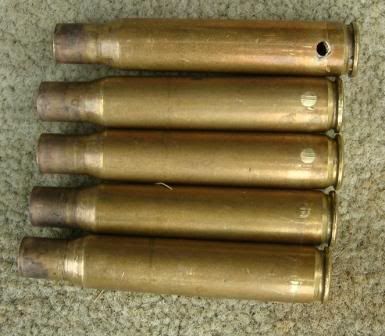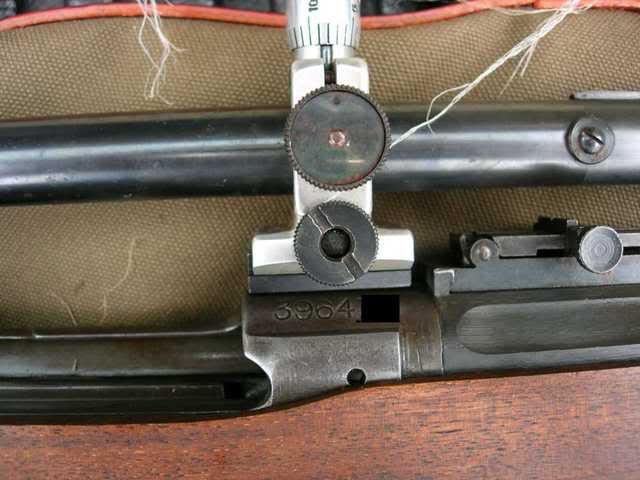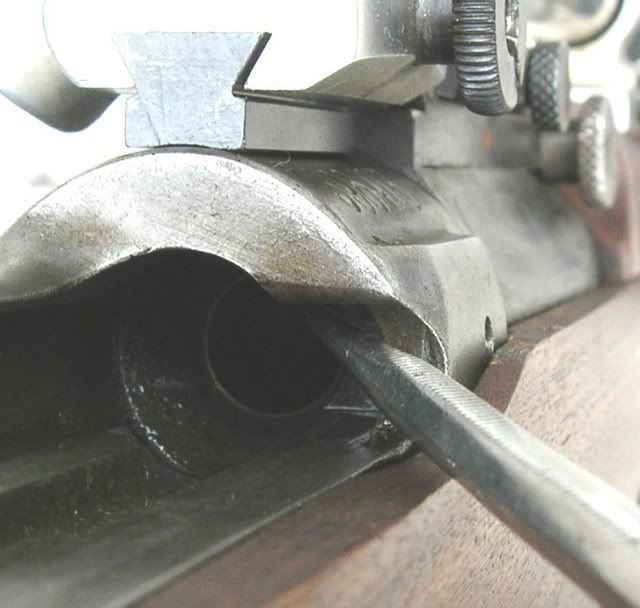You are using an out of date browser. It may not display this or other websites correctly.
You should upgrade or use an alternative browser.
You should upgrade or use an alternative browser.
Drilling a receiver
- Thread starter Abndoc
- Start date
Rifleman1776
New member
Other than the hard steel precaution....why not? Just make sure the underside of the holes is smooth an burr free.
Begin with a center drill.When you drill through with your tap drill think about what is happening with the cutting edges as they break through the threads.You will help if you can control the downfeed of the spindle so the drill isn't suddenly fed too big of a bite.If you run the quill depth stop up so you stop against it as you are drilling,you can roll it a little with your left thumb,feed to the stop,chip break,roll the stop a few thousandth more,etc.
If you lift the drill out,blow the chips out of the hole before you go back in.A chip spinning around in front of your drill tip is a problem.
As a drill is breaking through,the steel before the center tip of the drill gets very thin,and cutting geometry is less ideal in the center of a drill.
Like the primitive fire bow,heat can build quick as the steel thins.Some steels will suddenly get very hard.So,as you are about to break through,add some oil for coolant.
If you lift the drill out,blow the chips out of the hole before you go back in.A chip spinning around in front of your drill tip is a problem.
As a drill is breaking through,the steel before the center tip of the drill gets very thin,and cutting geometry is less ideal in the center of a drill.
Like the primitive fire bow,heat can build quick as the steel thins.Some steels will suddenly get very hard.So,as you are about to break through,add some oil for coolant.
Just my opinion, I will not drill a receiver with the barrel installed, taps are expensive, some taps are are tapered, some are called bottom taps, others are starter taps, all are subject to shattering when they stop for any reason when they stop or bottom out.
A friend building custom type rifles set up to drill and tap 20 barreled receivers, he called and ask if I wanted anything thrown in, I had three so I went over and drilled the receiver, out of 23 Mauser receivers not one offered resistance to being drilled nor have I ever found one that was 'tuffer' than the drill. I do have a spot annealer made from a spark plug insert, old movie carbon torch, wires and 12 volt battery source, it is a JIC tool, I got it, home made, just in case I need it.
On the three barreled receivers I took with me none were tapped, I will remove the barrel, then cut the threads, I had rather cut the screw to length than dig out a broken tap, Some set-up fixtures sold by Brownells and MidwayUSA require barrel removal unless the tool is modified..
F. Guffey
A friend building custom type rifles set up to drill and tap 20 barreled receivers, he called and ask if I wanted anything thrown in, I had three so I went over and drilled the receiver, out of 23 Mauser receivers not one offered resistance to being drilled nor have I ever found one that was 'tuffer' than the drill. I do have a spot annealer made from a spark plug insert, old movie carbon torch, wires and 12 volt battery source, it is a JIC tool, I got it, home made, just in case I need it.
On the three barreled receivers I took with me none were tapped, I will remove the barrel, then cut the threads, I had rather cut the screw to length than dig out a broken tap, Some set-up fixtures sold by Brownells and MidwayUSA require barrel removal unless the tool is modified..
F. Guffey
I have modified some Garand receivers and windage knobs to have Springfield Armory-type 1/2 minute clicks. This involves drilling into the receiver to make a hole for a detent ball spring, and grinding smooth, then cutting detent notches into the inside surface of the knob. I found I had to use carbide drill and mill bits for the two cutting operations. So, it is possible for a receiver to require a carbide bit, but I haven't noticed that issue with the Mausers specifically.
If you have to use carbide, it is best to have a very rigid and relatively vibration free drill. A milling machine is better than most home grade drill presses for that reason. Vibration causes the edges of the drills to chip and dull. Use of a fixture with a carbide drill guide insert is also advisable to prevent chipping and breakage.
If you have to use carbide, it is best to have a very rigid and relatively vibration free drill. A milling machine is better than most home grade drill presses for that reason. Vibration causes the edges of the drills to chip and dull. Use of a fixture with a carbide drill guide insert is also advisable to prevent chipping and breakage.
I have never found Mauser receivers to be very hard. M1903 and M1 Rifle receivers are another story, running 55-60 RC; they need to be annealed or a carbide bit and tap used. The carbide tools are so hard and brittle (and expensive) that I preferred to spot anneal the receiver.
As to removing the barrel before drilling, I agree that is the way to go, but I didn't do it. It takes too much time and there is too much potential for messing things up. It doesn't take a genius to figure out the maximum hole depth and set up the drill so you don't go too deep. There is no problem in drilling a bit into the barrel. Just don't ever try to remove a barrel with the scope mounts in place, just in case one of the screws does go into the barrel!
Drilling into the chamber is not always disaster. I repaired one rifle where the scope installer had drilled and tapped right through into the chamber. I removed the barrel, put in a screw, used a file, a Dremel tool and then a chambering reamer to cut the screw down and smooth up the chamber. Then I filed the outside of the screw to match the thread, and reinstalled the barrel. AFAIK, the rifle is still shooting OK.
Jim
As to removing the barrel before drilling, I agree that is the way to go, but I didn't do it. It takes too much time and there is too much potential for messing things up. It doesn't take a genius to figure out the maximum hole depth and set up the drill so you don't go too deep. There is no problem in drilling a bit into the barrel. Just don't ever try to remove a barrel with the scope mounts in place, just in case one of the screws does go into the barrel!
Drilling into the chamber is not always disaster. I repaired one rifle where the scope installer had drilled and tapped right through into the chamber. I removed the barrel, put in a screw, used a file, a Dremel tool and then a chambering reamer to cut the screw down and smooth up the chamber. Then I filed the outside of the screw to match the thread, and reinstalled the barrel. AFAIK, the rifle is still shooting OK.
Jim
Slamfire, I take it that was from a hole drilled too close to or partially into the chamber, and then it blew through?
Yupe. I know the gunsmith and was he embrassed.



